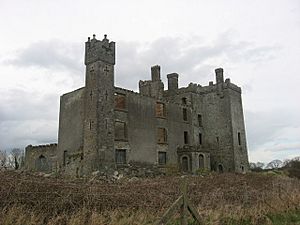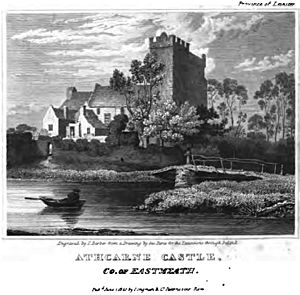Athcarne Castle facts for kids
Athcarne Castle is a ruined castle from the Elizabethan period located near Duleek in County Meath, Ireland. It's a place with a long history, from ancient burial mounds to battles and changing owners.
Contents
What's in a Name?
The name Athcarne likely comes from old Irish words. It might mean "Bridge at the Cairn" (Ath Cairn). A cairn is a pile of stones, often marking a burial mound. Or it could mean "High Cairn" (Ard Cairn).
There's a real burial mound near the castle, across the Hurley River. Some historians think the castle might even be built right on top of an ancient cairn. These cairns were built about 4,000 years ago! Vikings raided nearby Newgrange in 861, and it's thought they might have raided the cairns at Athcarne too.
Early Days and the Bathe Family
In 1172, the land where Athcarne Castle stands was given to an Anglo-Norman knight named Hugo De Bathe. He came from Bath in England. He probably built a simple defensive structure first. Over hundreds of years, this grew into a strong tower house.
The castle was greatly expanded in 1590. This was done by Sir William Bathe, a High Court judge, and his wife Janet Dowdall. When Sir William died in 1597, the castle went to his brother, James Bathe. Later, it passed to James's grandson, also named James Bathe, who owned it in the 1640s.
Cromwell's Attack on Athcarne
In 1649, a famous English leader named Oliver Cromwell marched north from Dublin. He had 12,000 soldiers and planned to capture Drogheda. On August 31st, his army took Ballygarth Castle. This castle was important because it controlled a river crossing.
The next day, the Earl of Ormonde, who was against Cromwell, ordered his troops to capture three other castles. These were Athcarne, Bellewstown, and Dardistown Castles. They were also important for controlling river crossings. However, Cromwell's soldiers were faster. They captured all three castles on September 1st and 2nd. This gave Cromwell control of the Nanny River, which was close to Drogheda.
New Owners and Old Families
After Cromwell captured Athcarne, he gave it to one of his officers, Colonel Grace. The Bathe family had to move to Ashbourne. James Bathe died before 1660. His son, Luke Bathe, tried hard to get their lands back.
However, a law called the Second Act of Settlement 1662 meant that Athcarne and many other lands were given to the Duke of York. This Duke later became King James II of England. The Bathe family never legally owned Athcarne again. But they were allowed to live there! In 1668, the Duke of York let Sir Luke Bathe rent Athcarne and 1,200 acres. He rented it for 99 years for a very small amount of money. This was called a "peppercorn" rent. The lease ended in 1767.
Legends and Changes
Many legends are told about Athcarne Castle. One popular story says that King James II slept there in 1690. This was on his way to the famous Battle of the Boyne, which was only six miles away. This story is quite believable because King James II actually owned the castle at that time! The Bathe family was just renting it from him.
Around 1700, the Bathe family left the castle. The Garnett family owned it for about 100 years. Then, around 1830, the Gernon family bought it. They made big changes to the castle. They kept the old tower house but knocked down the Elizabethan mansion built in 1590. They built a more modern extension with bigger windows, which was popular then. They also changed the front of the house to face south. They even created a boating lake in front of the castle by damming the Hurley River in winter. You can still see the dam today!
The Castle's Decline
The Gernon family later faced financial difficulties. In 1939, Athcarne Castle was sold at auction. The castle was stripped of its valuable parts, which were sold off. There was a plan to demolish the castle completely and use the stones for road building. But this plan never happened. Eventually, what was left of Athcarne Castle came under the care of the Irish State.



